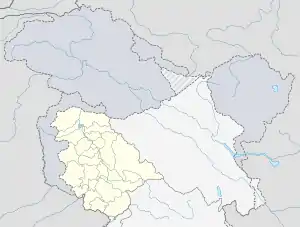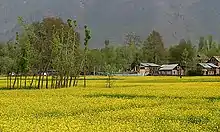Bandipore
Bandipore (English: /ˌbændɪˈpɔː/) or Bandipora is the headquarters of district of Bandipore in the union territory of Jammu and Kashmir, India. It is located on the northern banks of Wullar Lake—the second-largest freshwater lake in Asia. Bandipora has a terraced garden similar to that of Nishat Bagh in Srinagar. Bandipora is bound by mountains on three sides and by Wular Lake on the fourth. Bandipora is famous for three A's - A'lim (knowledge), Adab (good habits or literature) and Aab (water). As can be known from the folklore, the name of Bandipora originated either from Bund of Wular as Bund e pur, from the local folk-singing bands (bāṇd) as Baand e pur or from the enclosed (band) geographical location as Bandh e pur. Bandipora is bound by mountains on three sides and by Wular Lake in the fourth.
Bandipore
Bandipora | |
|---|---|
 Bandipore Location in Jammu and Kashmir, India  Bandipore Bandipore (India) | |
| Coordinates: 34.4167°N 74.6500°E | |
| Country | |
| Union Territory | Jammu and Kashmir |
| District | Bandipora |
| Population (2011) | |
| • Total | 3.92 lakhs |
| Languages | |
| • Official | Urdu |
| • Spoken | Kashmiri |
| Time zone | UTC+5:30 (IST) |
| Vehicle registration | JK15 |
| Website | http://bandipore.gov.in |
Geography
Bandipore is situated on the banks of the Wular, a large fresh-water lake which is home to a lot of migratory birds. Inadvertent dumping of the polluted river waters and sewage affluence has led to a pandemic growth of algae in the waters of the Wular which is threatening the lake and its supporting life itself. The main source of pollution to Wular is Jhelum River. The Jhelum River carries all the waste from Srinagar city and other surrounding areas and deposits it in Wular. Despite being the richest wetland of South Asia and the largest freshwater lake in Asia, no steps have been taken to save Wular. Bandipore is also a stepping town to the higher reaches of Razdan, Gurez and Tragbal.
The famous Lolab Valley in Kupwara district is adjacent to the Bandipore. It is just 30 kilometres (19 mi) from Bandipore via Aloosa village. Once this road is upgraded it will become a lifeline of the Lolab valley and it will provide an additional route to the Kupwara district.
Bandipore was the connecting link between North India and Central Asia via the Silk Road. At Pazalpora village there was a custom and immigration department which is now a forest check-post. Due to the fact, Bandipore is also known as the gateway to Central Asia. There are strong links between Skardu, Gurez and Bandipore.
Tehsils
Bandipore is divided into seven tehsils
- Bandipore
- Sumbal Sonawari
- Ajas
- Hajin
- Aloosa
- Gurez
- Tulail
Demographics
As of 2001 Indian census,[2] Bandipore had a population of 25,714. Males constitute 54% of the population and females 46%. Bandipore has an average literacy rate of 57.82%, lower than the national average of 59.5%, with 65% of the males and 35% of females literate. Twelve per cent of the population is under 6 years of age.
It has a Muslim majority though there are a few villages where Pandits also lived before they were ethnically cleansed from the region. The Pandit population were in large numbers at Ajar, Sonerwani, Kaloosa, Kharapora, Mantrigam, Aragam etc. Some Pandit families at Ajar and Kaloosa did not migrate. The temple at Kaloosa, known as Sharda Mandir, dates back to old times. It has a very big and old tree which is a few hundred years old and is a rare tree of its type. This is popularly known as Bran, a revered tree. There are many villages in this newly formed district named after Hindu gods and goddesses such as Chakreshipora, named after Chakerishwar. The forest training school of Kashmir is located in Bandipore. It was established in 1905. This institute is a premier body in the conservation process of the forest department.
The majority of the population speak Kashmiri. Gojri and Pahari are also spoken. Tehsil Gurez is Shina-speaking and has a Shina majority. There are few Pashtun villages on the Line of Control. The Kishan Ganga Hydro Electric Project is also located in the Gurez Tehsil of Bandipore. Project is worth Rs. 2700 Crore (Rs. 27 billion). It will generate 330 MW of electricity, which will be distributed from Kashmir.
Education
The literacy rate in the main town of Bandipore and adjoining areas is quite high. However, as per 2011 census, for whole district the literacy rate is one of the lowest in Jammu and Kashmir.
Towns and villages
The main township of Bandipore is called Plan. The name stuck after the area was constructed under a plan approved by Bakshi Ghulam Mohammad, ex-Prime Minister of Jammu and Kashmir, on his visit to incinerated town of Bandipore in 1963.[3] The important villages of Bandipore are Nowpora, Naz Colony, Dachigam, Ahamshareef, Arampora, Ajar, Aloosa, Aragam, Armpora, Arin, Ashtangoo, Athatoo, Ayathmullah, Barazullah, Badibeth, Badiyara, Bonakoot, Binlipora, Boothu, Brar, Braripora, Bilal Colony, Chekreshipora ,Chittiybanday, Chountimullah, Doban, Dogarpora, Dardpora, Dharamhama, Gamroo, Garoora, Gund-i-Dachina, Gundpora, Gund-i-Qaiser, Guzarbal, Goiwara, Harteng, Hudbal, Kaloosa, Kanibathi, Kehnoosa, Ketson, Kunusa, Kudara, Kemah, Khayar, Kharapora, Kralpora, Konan, Lawaypora, Lowdara, Laharwalpora, Lankreshipora, Mader, Malangam, Mangnipora, Mantrigam, Muqaam, Nadihal, Nusoo, Onagam/Wonagam/Sonagam, Paanaar, Panzigam, Papachan, Patushai, Pazalpora, Pethkoot, Qazipora, Quil, Rampora, Saderkoot (SK Payeen & SK Bala), Sheikhpora, Sonerwani, Sumlar, Tangath, Turkpora, Watrina, Watapora, Vewan, Zuri-manz etc. The main villages of Hajin are: Gulshanabad, Parebal, Madwan, Baniyari, Prang, Bangar Mohalla, Parray Mohalla, Bun Mohalla, Khomina, Baharabad e.t.c. The Famous Zain-Lank is situated at Baniyari 15 km from town of Hajin
There are various Sufi Shrines in Bandipora District. Some among them are BABA DAWOOD KHAKHI*(Located in Brar, Bandipora), Sheikh Hamza Makhdoomi (RA) located in Ahmaishareef One of the sacred places of the Hindus is Danishwar, locally also called Chota Amar Nath. It is a cave in dense forests of Arin. Pilgrims have to climb up about 60 metres to reach a cave where there are engraved features of Lord Shiva. People used to go there on the Sharvan Purnima, the date on which Amar Nath Yatra is being performed.
Attractions
Bandipore is the location of the Forest Training and Research Institute in Jammu and Kashmir [established in 1911]. It is 3 km distance from the main town. The Darul Uloom Raheemiyyah (School for Philosophers) is the largest religious institution in Jammu and Kashmir. It is the largest Islamic institution of valley headed by Moulana Mohammad Rahmatullah Mir Qasmi.
Bandipore is known for trekking, mountaineering and fishing. The famous Arin Nallah is home to one of the most exotic trout (Rainbow Trout, Silver Trout and Gray Trout).

Mount Harmukh

For mountaineers Mt Harmukh remains the main attraction, It is located in the eastern side of the town. Commercial cabs ply on that route till Kudara that is the farthest point where the cabs stop, and there onwards the terrain becomes hilly and one has to trek 17 kilometres (11 mi) to the higher reaches of Mount Harmukh. Sheera Sar [Lake of Spirits] acts as a base camp for all the mountaineering expeditions for Mt Harmukh. To the north lies Gurez, 86 kilometres (53 mi) from Bandipore. Commercial cabs ply on this route during summers, however in winters the route remains closed due to heavy snowfall.
The place is surrounded by areas of scenic beauty and ranges such as Sirandar, Kudara, Vewan, Mowa and Tresangam, all of which are inhabited by the Gujjars ("Bakarwals"). Although being a scenic place where peace and tranquility is in the environment, Bandipore has never been considered a tourist place and does not appear anywhere on the tourist map issued by Jammu and Kashmir State Tourism department.
References
- http://bandipore.gov.in/
- "Census of India 2001: Data from the 2001 Census, including cities, villages and towns (Provisional)". Census Commission of India. Archived from the original on 16 June 2004. Retrieved 1 November 2008.
- http://www.greaterkashmir.com/news/2011/Jan/4/-neglected-then-neglected-now--50.asp
